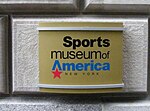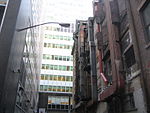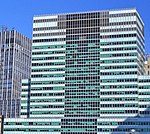26 Broadway

26 Broadway, also known as the Standard Oil Building or Socony–Vacuum Building, is an office building adjacent to Bowling Green in the Financial District of Lower Manhattan in New York City. The 31-story, 520-foot-tall (160 m) structure was designed in the Renaissance Revival style by Thomas Hastings of Carrère and Hastings, in conjunction with Shreve, Lamb & Blake. It was built as the headquarters of Standard Oil, once one of the largest oil companies in the United States. 26 Broadway is on a pentagonal site bounded by Broadway to the northwest, Bowling Green to the west, Beaver Street to the south, New Street to the east/southeast, and the axis of Morris Street to the north. The first sixteen stories occupy much of the lot, with several setbacks, a curved facade along Broadway, and two light courts. Above it is a twelve-story tower topped by a stepped pyramid. The ground story has a 40-foot-tall (12 m) lobby leading to three banks of elevators. The Standard Oil executive offices on the top stories included a board room on the 21st floor. The original structure was built in 1884–1885 for Standard Oil on the former site of U.S. treasury secretary Alexander Hamilton's house. The Standard Oil Building was expanded in 1895 and again after World War I, when Walter C. Teagle bought four neighboring buildings to create a continuous lot. The building was greatly expanded to its current size in a multi-phase construction project that took place between 1921 and 1928. 26 Broadway was sold to another owner in 1956 but remained a prominent structure on Bowling Green. In 1995, the New York City Landmarks Preservation Commission designated 26 Broadway as an official city landmark. It is also a contributing property to the Wall Street Historic District, a National Register of Historic Places district created in 2007.
Excerpt from the Wikipedia article 26 Broadway (License: CC BY-SA 3.0, Authors, Images).26 Broadway
Broadway, New York Manhattan
Geographical coordinates (GPS) Address External links Nearby Places Show on map
Geographical coordinates (GPS)
| Latitude | Longitude |
|---|---|
| N 40.705555555556 ° | E -74.013055555556 ° |
Address
26 Broadway
Broadway 26
10004 New York, Manhattan
New York, United States
Open on Google Maps










